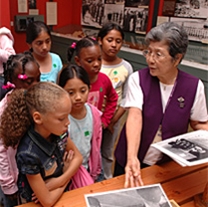Grant Spotlight | October 1, 2007
Share This |
Recipient: Japanese American National Museum, Los Angeles, CA Grant: 2005 National Leadership Grant |
Web site: Contact: |
||
At a time when Ken Burns’s "The War" is sparking fresh discussion of America’s involvement in World War II, educators in five states western states are building a new curriculum to help chronicle the conflict and shed new light on one of the nation’s darkest, and perhaps least heralded, chapters – the internment of Japanese Americans.
"We want people to look at history from a diverse range of perspectives and consider its relevance for all Americans today," says Allyson Nakamoto, a project director at the Japanese American National Museum in Los Angeles. "It is important, of course, for us to learn about the past. But it is just as important to examine the lessons of the past and the connections to the current issues surrounding diversity, civil liberties, and social justice."
Nakamoto oversees Enduring Communities: The Japanese American Experience in Arizona, Colorado, New Mexico, Texas and Utah, a three-year project that will incorporate the Japanese American experience into public school history curricula. The collaboration is funded in part by a 2005 IMLS National Leadership Grant of $995,325. National Leadership Grants recognize projects whose concepts can serve as a national paradigm – in this case, a collaboration of multiple states working together to build curricula around a shared concept.
While many Americans often associate the relocation and internment of some 65,000 Japanese Americans with California and the West Coast, Enduring Communities focuses on five states that, together, held 17 "War Relocation Centers" during World War II. Anchor institutions for the project include the University of Texas San Antonio’s Institute of Texan Cultures, Arizona State University’s Asian Pacific American Studies Program, the University of Colorado at Boulder, the University of New Mexico, and the Davis School District in Utah.
Enduring Communities builds on the success of the Japanese American National Museum’s 2004 project, Life Interrupted: The Japanese American Experience in World War II Arkansas, which brought the story to classrooms in Arkansas, home to two internment camps during the war. The focus: to give students a rarely opened window into local history as a way of looking at a broader national story.
"We want students to walk away asking questions," says Lyn Oshima, Program Coordinator for Secondary Education in the University of New Mexico’s Department of Teacher Education. "With the limited space we often have in textbooks and in curriculums, it’s hard to get a complete picture…
"We want students to know that communities can choose to be inclusive or exclusive; that racism and fears about national security have led us to set policies in the past that have violated the civil liberties of others; that government policies do affect people’s lives; that events in New Mexico very much reflected and affected the rest of the nation; and that the study of history is much more instructive when it is infused with a sense of empathy."
New Mexico holds intricate ties with America’s involvement in the war, from the development of the atomic bomb at Los Alamos to being the home to many Navajo code talkers. Towns around the state, like Clovis, saw their small Japanese American communities uprooted, while others like Gallup, fought successfully to keep them intact.
"World War II is very much lived, experienced, and talked about in this state," Oshima says.
It is also taught. Through the Enduring Communities project, five New Mexico schools are piloting programs that could soon be widely distributed to educators around the state. Carlos Gilbert Elementary School in Santa Fe, for example, used additional grant money from the History Channel to produce an opera about the internment experience. Teachers are integrating World War II literature specific to New Mexico into their curriculum. One high school technology teacher, meanwhile, is having students build collages in themes from photos taken in internment camps, and later writing essays about them.
"To complete this, they have to know something about the event…about photography…about the conditions in which the photos were taken…and about the photographer’s [agenda]," Oshima says. "This is not a reading generation. So a challenge is how we can use visuals to teach history, and use technology to interpret the past."
Other states are using their own bit of innovation to make the story come alive for students and still fit into tight syllabi.
In Utah’s Davis School District, one teacher at Syracuse Junior High has had students set up an exhibit at a local museum chronicling the Japanese American experience in Utah before, during, and after WWII. Another history teacher has created a website with students (www.hubtours.org/site/Home.html) that features podcasts of Japanese American oral histories and will also house a photo album, oral history transcripts, and lesson plans related to Enduring Communities. Educators will field test curriculum units for elementary, middle, and high school classes later this school year, before looking for wider distribution.
In the meantime, the Japanese American National Museum next July will host a national conference in Denver, Whose America? Who’s American? Diversity, Civil Liberties, and Social Justice, to showcase the work of the students and teachers, and discuss the continued relevance of the Japanese American experience. The conference will commemorate the 20th anniversary of the Civil Liberties Act of 1988, which granted redress to thousands of Japanese Americans and issued an official apology on behalf of the federal government to those affected by the policy.
"Just as we discovered in the project, Life Interrupted…we know that young people are interested in and even excited by history if they understand that it is their history," says Irene Hirano, President and CEO of the museum. "Teachers and students embraced the Japanese American story, as it represents an unknown chapter of their state’s history.
"As our national conference and the project will emphasize, these stories are still relevant in terms of civil liberties and social justice. This is another reason why we believe that young people will find American history of personal interest and a part of who they are today."

